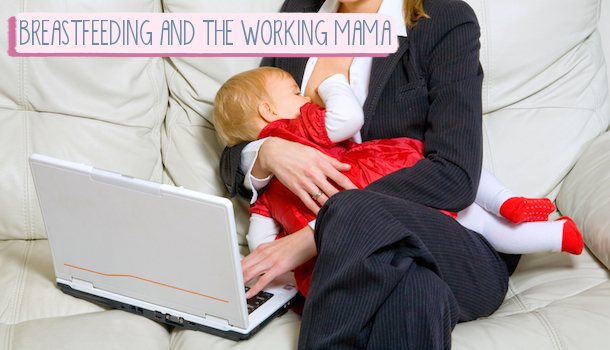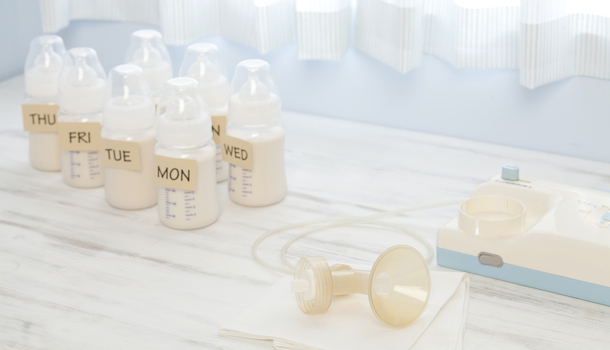
 Post Category - ParentingParenting - Post Category - BabyBaby
Post Category - ParentingParenting - Post Category - BabyBabyBreastfeeding is tricky enough in perfect conditions — how do you make it work when you, well, return to work? Take a deep breath and read on, mamas…
Increasingly, new mothers are returning to work after the birth of their baby, often for financial reasons but also – given that the average age to have a baby in Singapore is 29.8 – because they have successful careers that they want to continue. Many also return to full-time work due to a lack of part-time roles, flexible hours or work-at-home options.
A poll of 231 working mums by NTUC (National Trades Union Congress) found that 80% had returned to work after four months, and almost 50% of those had stopped breastfeeding by 6 months because of the challenges they faced: lack of time, flexibility, nature of work, lack of space & support.
The motivating factor for the mums who did continue was the health benefits for their babies. Beyond health benefits for mother and baby, continuing to breastfeed also helps to maintain a close bond, making it easier for both of you to cope with separation during the day, which for many mums is utterly heartbreaking in the early weeks.
Whatever your decision in how you are going to manage your return to work, it’s important to plan ahead and consider the following:
- Who is going to care for your baby?
- When will you return to work?
- When to start pumping?
- When to introduce a bottle?
- Where can you pump at work?
- How will you store your expressed milk at work?
- How will you transport your expressed milk?

So what are your options for breastfeeding and returning to work?
1. Continue exclusively breastfeeding – your baby is brought to your workplace to feed, or you work from home.
2. You provide expressed breastmilk (EBM) whilst you are separated from your baby.
3. Use formula milk when you are not there and continue breastfeeding at other times.
4. Return to work after 6 months, when your baby’s need for breastmilk will gradually decrease as he takes more solids.
The practicalities:
Introducing a bottle to your baby
Many mums who have struggled to get breastfeeding established are reluctant to introduce a bottle and risk upsetting the balance of their breastfeeding, but if this is left until a couple of weeks before returning to work the baby may refuse the bottle simply because he doesn’t know what to do with it, as the tongue action of feeding from a bottle is so different from the breast. It can lead to an extremely fraught time for mother and baby, and can spoil the last weeks of maternity leave, often with mum trying every different teat on the market in a desperate attempt for her baby to take a bottle.
Suggestions for the best time to start bottle feeding a breastfed baby vary in the recent research from 2 to 6 weeks. Two helpful markers are that the mother’s milk supply is well established and breastfeeding is going well. Waiting much later than 6 weeks often results in the baby strongly refusing the bottle, so somewhere between 4 to 6 weeks is probably ideal.
Expressing breast milk
When to start expressing depends on your future plans; if you are returning to work or need to be separated within a couple of months then starting in the early days may make it easier. Many mothers have an over supply in the early days so practising at this time can help you to be more successful and confident about expressing.
The best times to practise expressing are:
- After the first morning feed, as many mums have the most milk at this time.
- During your baby’s sleepy period; this may be early morning, late evening or if you have time, after feeds.
- If your baby only takes one breast per feed, express from the unused one.
- While the baby is feeding on one breast, try pumping from the other.
All of this this will also help build up your supply. There are no hard and fast rules about how often to express; most mums start once a day, on a regular basis until there is enough for one feed at that session. As it gets nearer to the time to return to work it is often helpful to pump several times a day, so that there is ample supply.

Breast Pumps
There are many different breast pumps on the market, but realistically if you are planning to pump while at work, a double electric pump with a hands free facility is the most realistic option because it is the most efficient. Second-hand pumps are not recommended because of the risk of cross infection from previous users, build-up of infectious particles and mould in the motor, and because the motor becomes less effective with prolonged use. Because breast pumps are very expensive in Singapore, try ordering one (or having a friend bring you one) from Europe, the U.S. or Australia.
About your let-down reflex:
The ‘let-down’ is the hormonal response to your baby’s sucking. It enables your baby to get most of the milk your breasts produce. Some mothers find it more difficult to let-down for a pump or hand expressing than breastfeeding and worry that they are not producing enough milk for their baby, but how much you express initially may not bear any relation to what your baby is getting. Most mothers find that the let-down response becomes more automatic with practise.
How to encourage let-down before expressing:
- Sit comfortably. Your body needs to be well supported.
- Relax. Practise deep breathing exercises you may have learnt at antenatal classes and relax your shoulders and chest. Pleasant, relaxing music can also help.
- Warmth. Apply gentle heat from a warm flannel.
- Massage. Lightly massage your breast towards the nipple before and during expressing. A shoulder massage can also help.
- Stimulation. Gently roll your nipples between your fingers.
- Your baby. Thinking of your baby when expressing, looking at his or her photo, or watching a video.
Expressing using a breast pump
Expressing both breasts together reduces time spent expressing, which can be crucial for working mums. The fat content of your milk can be increased if accompanied by breast compression — you may need a special bra to hold the pumps in place.

How much milk should I get each time?
This is going to vary from one mother to the next. As a rule of thumb, try to express more milk than you think your baby will need.
When you first start expressing, you may get very little, but the more you pump, the more milk you will obtain. Bear in mind your baby may take more than you expect as he won’t have the high fat milk at the end of the feed to ‘switch off’ his appetite. A rough guide to how much your baby will need each feed is calculated by:
Baby’s weight in kilos x 150 mls = amount in 24 hours divided by number of feeds.
For example: 5kg baby x 150mls = 750 mls divided by 8 feeds a day = approx 90 mls per feed.
Storage of breast milk.
Always label your expressed milk with the date so you can use it in the appropriate order.
The Singapore Health Promotion Board’s recommendations for the safe storage of breast milk are:
| Place of Storage | Recommended storage duration |
| Room Temperature of 25c | 4 hours |
| In a cooler with ice pack at 15c | 24 hours |
| Stored at the back of a fridge at 4c | 48 hours |
| Frozen milk in fridge/freezer-5 – -15c | 3 – 6 months |
| Frozen milk in deep freezer at – 20c | 6 – 12 months |
| Thawed breast milk in fridge at 4c | 24 hours |
Storage & transport of your expressed breast milk
Any BPA-free, clean container which can be sealed and frozen is suitable for storing expressed breast milk. The most popular are baby bottles or specially designed sterile milk storage bags. It is sensible to use small containers to avoid waste. When you are expressing at work, it is safest for your milk to be stored in sterile containers, stored in the back of a fridge a 4 c and transported home in an insulated cool bag, preferably with an ice pack. When storing milk in the freezer, store at the back – not in the door – to ensure a constant temperature.

Tips for your return
- Go into work a few weeks before your return to check out the pumping facilities. You will be anxious when you first go back about how the pumping is going to work, but if you have the logistics sorted out in your mind, you will be less anxious. Ideally you’ll want a private lockable room, or at the very least somewhere you won’t be disturbed.
- You’ll need somewhere to store your milk, preferably a fridge. Many mums don’t sterilize their pump equipment after every use, but store it in a ziplock bag in the fridge between pumping sessions, and sterilise it once a day at home.
- If there isn’t already a rota for the pumping facilities, organise one, with half hour slots, so you won’t feel anxious about someone trying to barge in during your allotted time.
- Practise your morning routine. How long will it take to get your baby ready, or will your carer do that? Do your work clothes fit? Will they camouflage leaky breasts?
- Pack an extra top and breast pads in case your breasts leak while you are at work.
- Practise leaving your baby with your caregiver.
- Start back on a Wednesday or Thursday so you will have a short week and avoid a busy Monday. It might be easier for you both to manage emotions with a short week.
- It is exhausting when you first go back to work, so try not to pack too much into the weekends.
Potential challenges on returning to work
- Leaking/engorgement: If it is difficult finding the time or an appropriate place to pump, mums may experience leaking of milk at inconvenient times, which can prove embarrassing.
- Many women experience a drop in their supply within the first few weeks of returning to work due to any number of factors: dehydration, lack of pumping/ difficulty getting a letdown, stress, or exhaustion. Many remedy this with extra direct feeding when with the baby, extra pumping, and the use of herbs like fenugreek, which in some women can increase milk supply.
- Reverse cycling – when baby is taking significantly less expressed milk than usual, just taking enough to keep him going, and waiting for his mum to return so he can catch up by feeding more often and for longer than usual. This means that mum’s sleep can be very disturbed as baby feeds frequently at night. However, some mothers encourage reverse cycling so they don’t need to pump as much milk. Reverse cycling is especially common in babies just getting used to the bottle.
Helpful links:
- Making it work toolkit: www.breastfeedingpartners.org
- www.kellymom.com
- www.workandpump.com
Continuing to breastfeed while working full-time involves a huge amount of organisation, commitment, and time; but most mums who have met these challenges and persevered through them will be very proud of their achievement, and will tell you that it was all worth it.
That at a time when their baby was being cared for much of the time by somebody else, they continued to offer their baby that unique thing that only they could offer – their breast milk – and they renewed that wonderful close bond with their baby at the end of each working day.






 View All
View All





 View All
View All









 View All
View All






